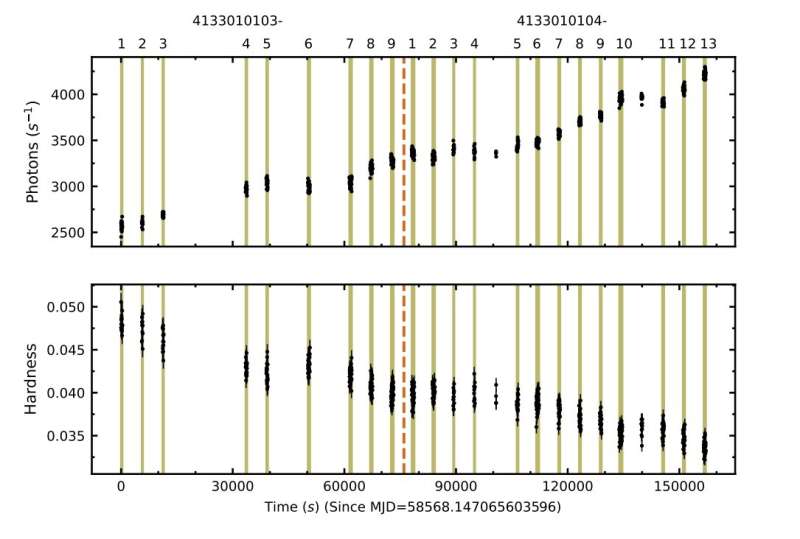June 7, 2023 report
This article has been reviewed according to Science X's editorial process and policies. Editors have highlighted the following attributes while ensuring the content's credibility:
fact-checked
preprint
trusted source
proofread
Observations explore the evolution of quasi-periodic oscillations in two X-ray binaries

Using the Hard X-ray Modulation Telescope (HXMT) and the Neutron star Interior Composition Explorer (NICER), astronomers from China and India have observed two X-ray binaries known as GX 339−4 and EXO 1846−031. Results of the observational campaign, published May 29 on the arXiv pre-print repository, reveal essential information regarding the evolution of quasi-periodic oscillations (QPOs) identified in these systems.
X-ray binaries (XRBs) are composed of a normal star or a white dwarf transferring mass onto a compact neutron star or a black hole. Based on the mass of the companion star, astronomers divide them into low-mass X-ray binaries (LMXB) and high-mass X-ray binaries (HMXB).
GX 339−4 and EXO 1846−031 are two black hole LMXBs discovered decades ago, both located within 39,000 light years away from the Earth. The masses of black holes in these two systems are estimated to be between four and 11 solar masses.
Previous observations of GX 339−4 and EXO 1846−031 have found that they exhibit QPOs. In general, such oscillations are believed to occur when X-rays are emitted near the inner edge of an accretion disk in which gas swirls onto a compact object like a neutron star or a black hole. Low frequency quasi-periodic oscillations (with frequencies ranging from a few mHz to 30 Hz) can be divided into three types: Type-A, -B, and -C QPOs, based on quality factor, noise type, fractional root-mean-square (rms), and phase delay.
GX 339−4 and EXO 1846−031 are known to showcase Type-C QPOs, which are characterized by a strong and narrow peak with a centroid frequency ranging from 0.01 Hz to 30 Hz superposed to a strong, 15%–30% fractional rms amplitude, broadband noise component. Recently, a team of astronomers led by Zuobin Zhang of the Fudan University in Shanghai, China, have performed HXMT and NICER monitoring of the Type-C QPOs in these two systems, hoping to get more insights into their evolution and properties.
The observations found that the evolution of the QPO frequency is closely related to mass accretion rate and inner disk radius in GX 339−4 and also in EXO 1846−031. The astronomers noted that such correlation follows the prediction of the dynamic frequency model. The dynamic frequency is the ratio of the sound propagation velocity of the inner disk to the truncation radius.
According to the paper, the Type-C QPOs in GX 339−4 and EXO 1846-031 appear at the end of low-hard state and/or hard-intermediate state. The study found a strong positive correlation between QPO frequency and photon index of the power-law in the beginning of observations, which flattens or starts reversing at the highest values of the QPO frequency.
The research also confirmed the high spin nature of the black hole in EXO 1846−031, which was suggested by previous studies that analyzed the blurred reflection spectra of this system.
More information: Zuobin Zhang et al, Evolution of QPOs in GX 339-4 and EXO 1846-031 with Insight-HXMT and NICER, arXiv (2023). DOI: 10.48550/arxiv.2305.18249
Journal information: arXiv
© 2023 Science X Network





















